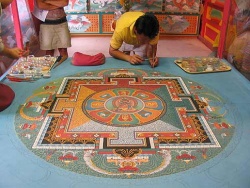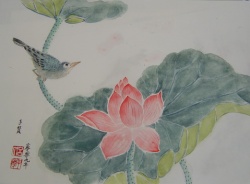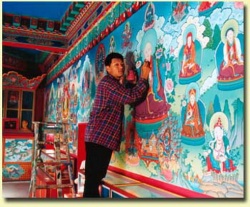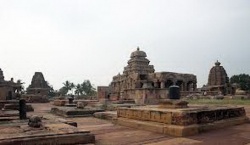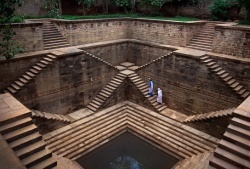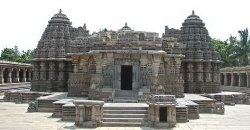The Buddhas (Nirmana-Kaya)
'The Buddhas who have been, are, and will be, are more numerous than the grains of sand on the banks of the Ganges' (Aparimita-Dharani).
The early Northern Buddhist school in Nepal adopted the system of 1,000 fictitious Buddhas, which so closely correspond to the 1,000 Zarathustras of the Zoroastrians that the system is believed to have originated in Persia. In this list appears for the first time the name of Amitabha, who became the fourth Dhyani-Buddha.
Hodgson gives a list of fifty-six Buddhas taken from the Lalita Vistara, in which the last seven Tathagata, called the 'Saptamanushi-Buddhas' (the seven human Buddhas), are:
Vipasyi,
Sikhi,
and Visvabhu of the preceding kalpa,3
and Krakucchanda,
Kanakamuni,
Kasyapa,
and Sakya-muni of the present cycle.
Sometimes the Dipankara Buddha and Ratnagarbha were added, making a group of nine Buddhas.
Later on, there appeared a group of twenty-four mythical Buddhas, of whom the Dipankara Buddha (the first of the twenty -four) is the best known, and Gautama Buddha is added to this group, making twenty-five in all. Sometimes the last seven of the group (including Gautama Buddha) are reckoned as the seven Principal Buddhas, who, with the coming Buddha Maitreya, form a group of eight, and eight has remained a popular number among Buddhists for grouping the gods (the eight Bodhisattva, the 'eight Terrible Ones', &c).
The group of the five Manushi-Buddhas, 4 corresponding with the five DhyaniBuddhas and five Dhyani-Bodhisattva, became, however, the most popular in Nepal; and was adopted not only in Tibet, but in China and Japan, and has lasted up to the present day.
A Manushi-Buddha, according to the system of Adi-Buddha, is one who has acquired such enlightenment (bodhi-jnana) by his previous incarnations as Bodhisattva, that he is capable of receiving Bodhi, or Supreme Wisdom, a particle of the essence of Adi-Buddha. He has become a Tathagata 5 and can have no more rebirths, but at his death will attain Nirvana-pada, or absorption into the Adi-Buddha.
Those of the Northern Buddhist sects that did not adopt the system of Adi-Buddha, looked upon the Manushi-Buddha as a manifestation of, or an emanation from, the Dhyani-Buddha; or, according to the system of the Tri-kaya, as a distinct nature or body (kaya) representing the embodiment of intellectual essence.
The system of the Tri-kaya 6 supposed each Buddha to have three kaya or [Page 10] bodies — 'that is to say, three distinct natures, which might be said to be living in three spheres at the same time.
On earths Manushi-Buddha — mortal and ascetic, having passed through innumerable transformations on earth and arrived at the Nirmana-kaya state of practical Bodhi (knowledge).
In Nirvana, as Dhyani-Buddha — abstract body of absolute purity, in the Dharma-kaya state of essential Bodhi.
In reflex in the Rupadhatu heavens as Dhyani-Bodhisattva, body of supreme happiness, in the Sambhoga-kaya state of reflected Bodhi. 7
The kaya of a Manushi-Buddha is material, visible, and perishable. Being of human form, the Manushi-Buddha is born into the world and released from it by death. He did not, however, enter the world as a Buddha but as a Bodhisattva, nor did he reach the stage of Buddhahood until the moment when he attained Supreme Enlightenment, such as Sakya-muni under the Bodhi-tree
'After the Enlightenment',
according to M. de la Vallee Poussin, 8
'nothing earthly, human, heavenly, or mundane remains of a Tathagata. Therefore his visible appearance is but a contrived or magical body . . . the unsubstantial body which remains of a Bodhisattva after he has reached Buddhahood.'
It was believed by the Mahayanists that when the Bodhisattva arrived at the stage of Bodhi, he would have acquired the thirty-two superior and eighty inferior outward marks 9 of a Buddha. In the Mahavastu it is written that the future Buddha would have all the outward 'signs' at his last rebirth; 10 but the representations of Sakya-muni as a child do not show the protuberance on the skull 11 (ushnisha) which is the most important and probably the last acquired of the thirty-two outward signs. Nor as an ascetic is he represented with the full-sized ushnisha. 12 It is only after his attainment of Supreme Wisdom that the representations of the Buddha show the fully-developed protuberance on the skull — the receptacle, presumably, of the divine mind (manas), which was thought too great to be held in a normalsized skull.
Although the different Mahayana sects disagreed as to the source of the divine intelligence, they were all of accord in believing that after the attainment of Bodhi the ' body ' of the Tathagata was animated by a divine force. This 'body of Transformation' (Nirmana-kaya) of the Manushi-Buddha has been variously explained. M. de la Vallee Poussin is of the opinion that it is a 'magical' body, in other words, an illusion; while Mr. G. B. S. Mead calls it the 'outer shell of the inner body of [Page 11] Transformation'. Might it not also mean the transformation of the 'body' of the Bodhisattva as he approaches Buddhahood — the acquiring (or developing) one byone, in his different rebirths, of the thirty-two superior and eighty inferior marks which are outward proofs of his inner progress toward Bodhi?
Certain Northern Buddhist sects designated the Tri-kaya by the triad 'Buddha, Dharma, and Sahgha'.
'Buddha' symbolized the generative power,
'Dharma' (or Prajna) the productive power, and their union produced
'Sangha' (DhyaniBodhisattva), the active author of creation.
The Manushi-Buddha is always represented in monastic garments without ornaments, and with the right shoulder and breast, or only the breast, bare, and with the urna, 13 ushnisha, and long-lobed ears. He is usually seated with closely locked legs, but may also be standing.
Suzuki, in his Outlines of Mahdyana Buddhism, writes:
'If we draw a parallel between the Buddhist and the Christian Trinity,
the Body of Transformation (Nirmana-kaya) may be considered to correspond to Christ in the flesh,
the Body of Bliss (Sambhoga-kaya) either to Christ in glory or to the Holy Ghost,
and Dharmakaya to the Godhead.'
